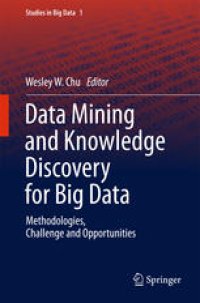
Ebook: Data Mining and Knowledge Discovery for Big Data: Methodologies, Challenge and Opportunities
- Tags: Computational Intelligence, Artificial Intelligence (incl. Robotics)
- Series: Studies in Big Data 1
- Year: 2014
- Publisher: Springer-Verlag Berlin Heidelberg
- Edition: 1
- Language: English
- pdf
The field of data mining has made significant and far-reaching advances over the past three decades. Because of its potential power for solving complex problems, data mining has been successfully applied to diverse areas such as business, engineering, social media, and biological science. Many of these applications search for patterns in complex structural information. In biomedicine for example, modeling complex biological systems requires linking knowledge across many levels of science, from genes to disease. Further, the data characteristics of the problems have also grown from static to dynamic and spatiotemporal, complete to incomplete, and centralized to distributed, and grow in their scope and size (this is known as big data). The effective integration of big data for decision-making also requires privacy preservation.
The contributions to this monograph summarize the advances of data mining in the respective fields. This volume consists of nine chapters that address subjects ranging from mining data from opinion, spatiotemporal databases, discriminative subgraph patterns, path knowledge discovery, social media, and privacy issues to the subject of computation reduction via binary matrix factorization.
The field of data mining has made significant and far-reaching advances over the past three decades. Because of its potential power for solving complex problems, data mining has been successfully applied to diverse areas such as business, engineering, social media, and biological science. Many of these applications search for patterns in complex structural information. In biomedicine for example, modeling complex biological systems requires linking knowledge across many levels of science, from genes to disease. Further, the data characteristics of the problems have also grown from static to dynamic and spatiotemporal, complete to incomplete, and centralized to distributed, and grow in their scope and size (this is known as big data). The effective integration of big data for decision-making also requires privacy preservation.
The contributions to this monograph summarize the advances of data mining in the respective fields. This volume consists of nine chapters that address subjects ranging from mining data from opinion, spatiotemporal databases, discriminative subgraph patterns, path knowledge discovery, social media, and privacy issues to the subject of computation reduction via binary matrix factorization.